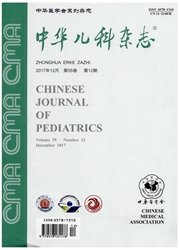

 中文摘要:
中文摘要:
目的 了解不典型Rett综合征患儿MECP2基因的突变频率、突变类型、是否存在突变热点,寻找基因型和表型的相互关系。方法取26例不典型Rett综合征患儿外周静脉抗凝血,采用Miller’s蛋白酶K氯化钠盐析法提取基因组DNA,采用PCR方法扩增MECP2基因的外显子及结合区,1%的琼脂糖凝胶电泳鉴定目的PCR产物,然后进行DNA直接测序。DNA测序结果与人基因组序列(GeneBank AF030876)比较。结果26例不典型Rett综合征患儿中有12例存在突变。突变类型包括错义突变,由于单个碱基缺失导致的移码突变和剪切位点的突变,其中错义突变为最常见类型。c.397C〉T为3例,c.473C〉T、c.916C〉T、c.806delG各为2例,c.397A〉G、c.1005G〉A、c.IVS2-2A〉T各为1例。结论不典型Rett综合征患儿存在MECP2基因突变,R133C、T158M和R306C为其热点突变。基因突变类型和表型之间有一定的相关性。
 英文摘要:
英文摘要:
Objective Rett syndrome (RTT) is an X-linked progressive neurodeveopmental disorder that almost exclusively affects girls, and is one of the most common causes of mental retardation in females, with an estimated prevalence of approximately 1 in 10 000-15 000 female individuals. Mutations in X-linked methyl-CpG-binding protein 2 (MECP2) gene, located on chromosome Xq28, have been found to be a cause of RS. A lot of mutations have been reported to be related to RS recently. Mutations are found in 70% -85% of patients with classical RTF and in less than 50% of patients with atypical RS. Up to now, RTr is diagnosed based on a consistent counseling for clinical features and the established diagnostic criteria. The present study aimed to investigate frequency and type of mutation of MECP2 gene and if hot spot of mutation exits in patients with atypical RTT and find out the relationship between genotype and phenotype. Methods A systematic analysis of the entire coding region of MECP2 in 26 unrelated patients with atypical RTT was performed by polymerase chain reaction (PCR) and direct sequencing. Genomic DNA was extracted using standard procedures from the peripheral blood leukocytes of each patient. PCR amplification products were checked by 2% agarose gel electrophoresis and were subsequently sequenced with ABI 3730 Automated DNA Sequencer with both the forward and reverse primers. Mutational analyses were performed using normal human genomic MECP2 sequence as a reference ( GenBank accession NO. AF030876 ). Results Seven mutations were identified in 12 of 26 patients. Most of the mutations were missense mutation ; c. 397C 〉 T (R133C) was found in 3 of 26 patients; c. 473C 〉T(T158M) and c. 916C 〉 T(R306C) were found in 2 of 26 patients, respectively; c. 397A 〉 G(R133H) and c. 1005G 〉 A(R335C) were found in 1 of 26 patients, respectively. One base pair deletion mutation (806delG) resulting in frameshift was found in 2 of 26 patients, and 1 base pair transversion at splic
 同期刊论文项目
同期刊论文项目
 同项目期刊论文
同项目期刊论文
 期刊信息
期刊信息
